List of fermented foods
See also: List of fermented soy products

A woman preparing kenkey
This is a list of fermented foods, which are foods produced or preserved by the action of microorganisms. In this context, fermentation typically refers to the fermentation of sugar to alcohol using yeast, but other fermentation processes involve the use of bacteria such as lactobacillus, including the making of foods such as yogurt and sauerkraut. The science of fermentation is known as zymology.
Many pickled or soured foods are fermented as part of the pickling or souring process, but many are simply processed with brine, vinegar, or another acid such as lemon juice.
Fermented foods
| Name | Image | Origin | Description | |
|---|---|---|---|---|
| Amasi | .jpg) |
A word for fermented milk that tastes like cottage cheese or plain yogurt. It is very popular in South Africa. | ||
| Amazake |  |
Japan | A traditional sweet, low- or non-alcohol (depending on recipes) Japanese drink made from fermented rice. | |
| Appam | |
India | A type of South Indian pancake made with fermented rice batter and coconut milk. It is a popular food in South Indian states of Kerala and Tamil Nadu. It is also very popular in Sri Lanka where it is commonly referred to by its anglicized name as Hoppers. | |
| Atchara | .jpg) |
A pickle made from grated unripe papaya that is popular in the Philippines. It is often served as a side dish for fried or grilled foods such as pork barbecue. The name may come from several names for South Asian pickle and is related to acar from neighbouring Indonesia and Malaysia. | ||
| Ayran |  |
A cold yogurt beverage mixed with salt.[1] In addition to Turkey, where it is considered a national drink, ayran is found in Iran (here called doogh), Afghanistan, Armenia (here called tan), Azerbaijan, the Balkans, Kazakhstan, Kyrgyzstan, Lebanon, Syria and across the Caucasus.[2] Its primary ingredients are water and yogurt. | ||
| Bagoong | |
Philippines | A Philippine condiment made of partially or completely fermented fish or shrimp and salt.[3] The fermentation process also results in fish sauce (known as patis).[4] | |
| Bagoong monamon |  |
Prepared by fermenting salted anchovies | ||
| Bagoong terong | 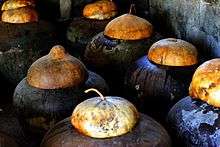 |
Made by salting and fermenting the bonnet mouth fish | ||
| Bánh cuốn | 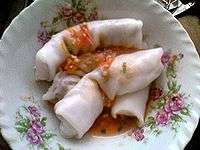 |
Northern Vietnam.[5] | Made from a thin, wide sheet of steamed fermented[6] rice batter filled with seasoned ground pork, minced wood ear mushroom, and minced shallots. | |
| Blaand | A fermented milk product made from whey. It is similar in alcohol content to wine. | |||
| Boza |  |
A traditional fermented drink with alcohol found in many countries | ||
| Bread |  |
Some breads, such as sourdough, use dough that is fermented | ||
| Brem | |
Indonesia | A traditional fermented food of Indonesia that uses rice. | |
| Burong mangga | Philippines | Made by mixing sugar, salt, and water to mangoes that have previously been salted | ||
| Calpis | Japan | An uncarbonated soft drink, manufactured by Calpis Co., Ltd. that is produced using lactic acid fermentation | ||
| Chass | Gujarat, India | The word used for buttermilk in Rajasthani and Gujarati.[7] Chass is the traditional Gujarati beverage from Gujarat, India. | ||
| Cheese |  |
Some cheeses, such as Shanklish (pictured), are fermented as part of their production | ||
| Cheonggukjang |  |
Korea | A fermented soybean paste used in Korean cuisine that contains both whole and ground soybeans | |
| Chicha |  |
In South America and Central America, chicha is a fermented or non-fermented beverage usually derived from maize.[8] Chicha includes corn beer known as chicha de jora and non-alcoholic beverages such as chicha morada. | ||
| Chinese pickles | Various vegetables or fruits, which have been fermented by pickling with salt and brine or marinated in mixtures based on soy sauce or savory bean pastes | |||
| Cocoa |  |
Cocoa bean fermentation for chocolate, and other cocoa products | ||
| Cod liver oil (Traditional preparation method) | Cod liver oil was traditionally manufactured by filling a wooden barrel with fresh cod livers and seawater and allowing the mixture to ferment for up to a year before removing the oil. | |||
| Crème fraîche |  |
A soured cream containing 30–45% butterfat and having a pH of around 4.5.[9] It is soured with bacterial culture, but is less sour than U.S.-style sour cream, and has a lower viscosity and a higher fat content. | ||
| Curtido |  |
A type of lightly fermented cabbage relish. It is typical in Salvadoran cuisine and that of other Central American countries, and is usually made with cabbage, onions, carrots, and sometimes lime juice | ||
| Dhokla |  |
Gujarat, India | A vegetarian food item made with a fermented batter derived from rice and chickpea splits.[10] | |
| Doenjang | 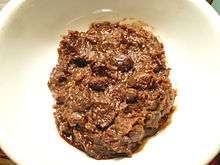 |
Korea | A thick bean paste that includes fermentation in its preparation | |
| Doogh | |
Ancient Persia | A savory yogurt-based beverage | |
| Dosa | |
India | A fermented crepe or pancake made from rice batter and black lentils. It is a staple food in many parts of India. Pictured is Rava dosa, a type of Dosa dish.Plain dosa and Masala dosa are better fermented dishes.The batter is fermented for 8 to 10 hrs. | |
| Doubanjiang |  |
A spicy, salty paste made from fermented broad beans, soybeans, salt, rice, and various spices | ||
| Douchi |  |
A type of fermented and salted black soybean | ||
| Fermented bean curd |  |
Fermented tofu (pictured) is a type of Fermented bean curd | ||
| Fermented bean paste |  |
A category of fermented foods typically made from ground soybeans, which are indigenous to the cuisines of East and Southeast Asia. In some cases, such as in the production of miso, other varieties of beans such as broad beans, may also be used.[11] | ||
| Fermented fish | 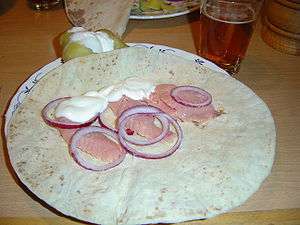 |
A traditional preparation of fish. Before refrigeration, canning and other modern preservation techniques became available, fermenting was an important preservation method. | ||
| Fermented milk products | Also known as cultured dairy foods, cultured dairy products, or cultured milk products, fermented milk products are dairy foods that have been fermented with lactic acid bacteria such as Lactobacillus, Lactococcus, and Leuconostoc. Pictured is matzoon, a fermented milk product of Armenian origin. | |||
| Filmjölk |  |
Nordic countries | A mesophilic fermented milk product that is made by fermenting cow's milk with a variety of bacteria from the species Lactococcus lactis and Leuconostoc mesenteroides.[12][13] | |
| Fish sauce |  |
|||
| Ganjang |  |
Korea | a kind of Korean soy sauce made from fermented soybeans Ganjang is a uniquely Korean condiment | |
| Garri | .jpg) |
|||
| Garum | Garum was a fish sauce made from the fermentation of fish entrails, used as a condiment in the cuisines of ancient Greece, Rome, and Byzantium. It is believed to have resembled the fermented anchovy sauce colatura di alici still produced today in Campania, Italy. | |||
| Gejang |  |
Korea | ||
| Gochujang |  |
Korea | ||
| Gundruk |  |
- Nepal | Gundruk is made by fermenting leaves of vegetables of Brassica family. | |
| Hákarl | |
Iceland | Made by fermenting shark meat, then hanging it to dry. Pictured is Hákarl hanging to dry in Iceland | |
| Hongeohoe |  |
Korea | ||
| Idli | |
India | ||
| Igunaq | 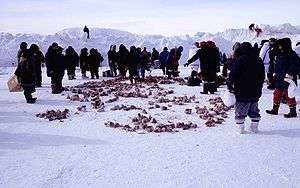 |
|||
| Injera |  |
A sourdough-risen flatbread with a unique, slightly spongy texture. Traditionally made out of teff flour,[14] it is a national dish in Ethiopia and Eritrea. | ||
| Iru (food) | |
|||
| Jeotgal | 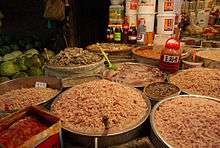 |
Korea | ||
| Jogijeot | Made with fish in Korea. | Korea | ||
| Kapusta kiszona duszona | |
Poland | ||
| Katsuobushi |  |
Japan | ||
| Kaymak | ||||
| Kefir | |
A fermented milk product | ||
| Kenkey |  |
|||
| Ketchup |  |
In Indonesian cuisine, which is similar to Malay, the term kecap refers to fermented savory sauces. | ||
| Khanom chin | |
|||
| Kimchi |  |
Korea | ||
| Kisela repa | Fermented shreds of turnip, used in bean soup or as a side usually in winter meals in continental Croatian cuisine. | |||
| Kiviak | Kiviak or kiviaq is a traditional wintertime Inuit food from Greenland that is made of auks preserved in the hollowed-out body of a seal. | |||
| Kombucha |  |
|||
| Kumis | 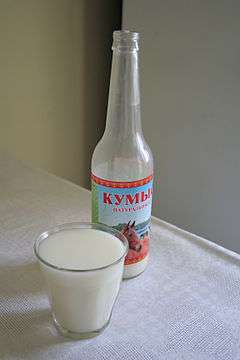 |
|||
| Kusaya | Japan | A traditional salted and fermented fish dish originating in the Izu Islands, and often eaten with sake, shōchū, or a local drink called Shima Jiman. | ||
| Kuzhi paniyaram | 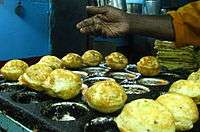 |
|||
| Kvass |  |
|||
| Lassi | 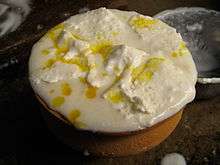 |
|||
| Leben (milk product) | ||||
| Lufu (food) | ||||
| Mageu | |
|||
| Meigan cai |  |
|||
| Miso |  |
|||
| Mixian (noodle) |  |
|||
| Mohnyin tjin | |
|||
| Murri (condiment) | ||||
| Mursik | ||||
| Myeolchijeot |  |
Korea | ||
| Myeongran | Korea | |||
| Nata de coco | |
|||
| Nattō |  |
Japan | ||
| Nem chua | 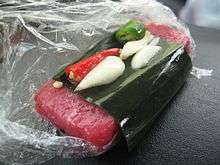 |
Vietnam | Nem chua is a Vietnamese fermented pork dish, usually rolled or cut in bite sizes. The meat is sweet, sour, salty and spicy. It is often served with bird's eye chili, garlic and Vietnamese coriander. | |
| Ngapi | |
|||
| Ogi (cereal ferment) | ||||
| Ogiri | ||||
| Oncom |  |
|||
| Palappam | ||||
| Pesaha Appam |  |
|||
| Peuyeum | |
|||
| Pickles[15] |  |
|||
| Podpiwek | Poland, Lithuania | Soft drink usually made from grain coffee, hops, yeast, water and sugar, which undergo fermentation. | ||
| Poi (food) |  |
|||
| Pulque | |
|||
| Puto |  |
Pictured is puto in banana leaf | ||
| Rakfisk |  |
|||
| Rượu nếp |  |
|||
| Ryazhenka | |
|||
| Saeujeot | 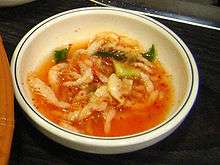 |
Korea | ||
| Salami | Italy | |||
| Sauerkraut |  |
Finely cut cabbage that has been fermented by various lactic acid bacteria, including Leuconostoc, Lactobacillus, and Pediococcus.[16][17] It has a long shelf life and a distinctive sour flavor, both of which result from the lactic acid that forms when the bacteria ferment the sugars in the cabbage. | ||
| SCOBY | ||||
| Şalgam |  |
Turkey | Şalgam is a popular beverage from southern Turkey's cities of Adana and Mersin. It is made with the juice of red carrot pickles, salted, spiced, and flavoured with aromatic turnip (çelem) fermented in barrels with the addition of ground bulgur. | |
| Shark meat | .jpg) |
Shark meat is sometimes fermented. | ||
| Shiokara |  |
|||
| Shrimp paste |  |
|||
| Sinki (food) | ||||
| Skyr | 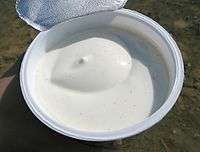 |
|||
| Smântână | |
|||
| Smetana (dairy product) | 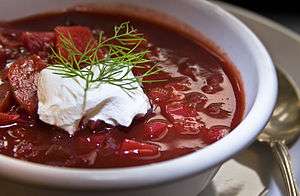 |
|||
| Som moo |  |
|||
| Sour cabbage |  |
Vegetable preserve similar to sauerkraut, with the difference that it is prepared through the lacto-fermentation of whole heads of cabbage (Brassica Oleracea var.capitata), not separate leaves or grated mass. | ||
| Sour cream | |
Obtained by fermenting a regular cream with certain kinds of lactic acid bacteria.[18] The bacterial culture, which is introduced either deliberately or naturally, sours and thickens the cream. Pictured is Smetana. | ||
| Soured milk |  |
|||
| Sowans | ||||
| Soy sauce | 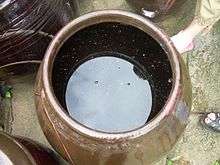 |
Korea, Japan, China | Pictured is traditional Korean soy sauce | |
| Ssamjang |  |
Korea | ||
| Stinky tofu |  |
|||
| Strained yogurt | 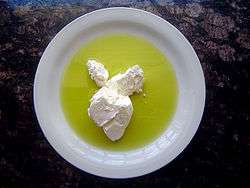 |
|||
| Suan cai |  |
|||
| Sumbala | (Parkia_biglobosa)%2Csd%2Cpd(soumbala)_Kera(D%C3%A9dougou_Distr.)%2CBF_thu05jun2014-1014h.jpg) |
|||
| Súrmjólk | ||||
| Surströmming |  |
|||
| Tabasco sauce |  |
|||
| Tapai | |
|||
| Tarhana | |
|||
| Tempeh | 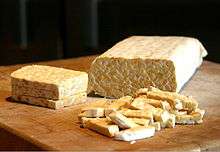 |
Indonesia | A traditional soy product originally from Indonesia that is made by a natural culturing and controlled fermentation process that binds soybeans into a cake form | |
| Tesgüino | ||||
| Tianjin preserved vegetable | |
|||
| Tianmianjiang | 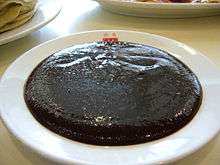 |
|||
| Tibicos | %2C_after_2_days.jpg) |
|||
| Tsukemono |  |
|||
| Tương | ||||
| Viili | ||||
| White sugar sponge cake |  |
|||
| Worcestershire sauce |  |
|||
| Yakult |  |
|||
| Yellow soybean paste | ||||
| Yogurt |  |
A fermented milk product produced by the bacterial fermentation of milk | ||
| Zha cai |  |
|||
| Chakuli pitha |  |
India | A rice-based fried pancake traditionally made in the Indian state of Odisha. It is made from fermented rice and black gram | |
| Enduri Pitha | |
India | A traditional pitha made in the in the northern and central region Indian state of Odisha. A fermented batter made of rice and black gram is steamed with/without stuffing made of coconut, jaggery and black pepper. | |
| Žinčica | Žinčica (in Slovakia), Žinčice (in the Czech Republic), Żentyca (in Poland) | A drink made of sheep milk whey as a by-product in the process of making bryndza cheese.. |
See also
- Fermentation (wine)
- Food microbiology
- List of fermented soy products
- List of fish sauces
- List of pickled foods
References
- ↑ A. Y. Tamime (ed.) (2008). Fermented Milks. John Wiley & Sons. p. 124. ISBN 9781405172387.
- ↑ For popularity in Armenia, Azerbaijan, Kazakhstan, and Kyrgyzstan see Yildiz Fatih (2010). Development and Manufacture of Yogurt and Other Functional Dairy Products. CRC Press. p. 10. ISBN 9781420082081.
For the Balkans, see Leslie Strnadel, Patrick Erdley (2012). Bulgaria (Other Places Travel Guide). Other Places Publishing. p. 58. ISBN 9780982261996.
- For use in Afghanistan by Kirghiz, see Nazif Shahrani, M. (2013). The Kirghiz and Wakhi of Afghanistan. 9780295803784: University of Washington Press. pp. 92–93.
- For Lebanon, see A. Y. Tamime (ed.) (2008). Fermented Milks. John Wiley & Sons. p. 96. ISBN 9781405172387.
- For presence in the North Caucasus, see Smih, Sebastian (2006). Allah's Mountains: The Battle for Chechnya. Tauris Parke Paperbacks. p. 25. ISBN 9781850439790.
- ↑ J. Dagoon (2000). Agriculture & Fishery Technology III. Rex Bookstore, Inc. pp. 242–243. ISBN 978-971-23-2822-0.
- ↑ National Research Council (U.S.). Panel on the Applications of Biotechnology to Traditional Fermented Foods (1992). Applications of biotechnology to traditional fermented foods: report of an ad hoc panel of the Board on Science and Technology for International Development. National Academies. pp. 132–133.
- ↑ Lonely Planet Vietnam (Italian) "bánh cuốn – involtini di carta di riso cotti a vapore, ripieni di carne di maiale tritata e gamberi disidratati;"
- ↑ T.H. Yellowdawn: Fermented Foods (2008); p.302-p.304
- ↑ Suresh Singh, Kumar; Rajendra Behari Lal (2003). Gujarat. Popular Prakashan. p. 789. ISBN 81-7991-104-7.
- ↑ Michael Andrew Malpass, Daily Life in the Inca Empire. Retrieved 31 August 2008
- ↑ Meunier-Goddik, L. (2004). "Sour Cream and Creme Fraiche". Handbook of Food and Beverage Fermentation Technology. CRC Press. doi:10.1201/9780203913550.ch8. ISBN 978-0-8247-4780-0., p. 181f
- ↑ Redhead, J. F. (1989). Utilization of tropical foods. Food & Agriculture Org. p. 26. ISBN 978-92-5-102774-5.
- ↑ The Book of Miso, 2nd ed., by Shurtleff and Aoyagi. Berkeley, California: Ten Speed Press (1985)
- ↑ "Filmjölk" (in Swedish). Arla Foods. Retrieved 2007-06-29.
- ↑ "Ekologisk filmjölk odd milk" (in Swedish). Arla Foods. Retrieved 2007-06-30.
- ↑ Science of Bread: Ethiopian injera recipe
- ↑ "Science of Pickles: Fermentation and Food | Exploratorium". Exploratorium.edu. Retrieved 2013-11-02.
- ↑ Farnworth, Edward R. (2003). Handbook of Fermented Functional Foods. CRC. ISBN 0-8493-1372-4.
- ↑ "Fermented Fruits and Vegetables - A Global SO Perspective". United Nations FAO. 1998. Retrieved 2007-06-10.
- ↑ "What is sour cream. Sour cream for cooking recipes". Homecooking.about.com. 2010-06-14. Retrieved 2011-09-14.
External links
-
 Media related to Fermented food at Wikimedia Commons
Media related to Fermented food at Wikimedia Commons
This article is issued from Wikipedia - version of the 9/29/2016. The text is available under the Creative Commons Attribution/Share Alike but additional terms may apply for the media files.